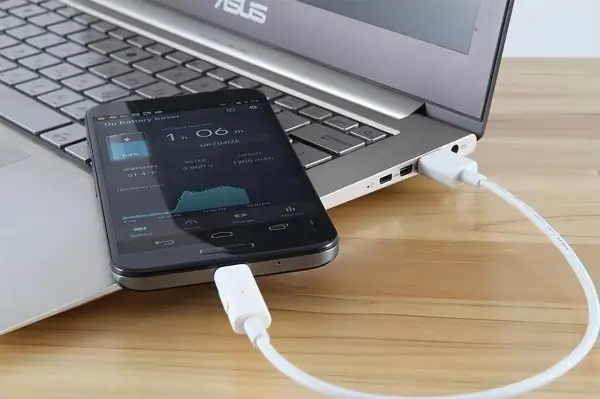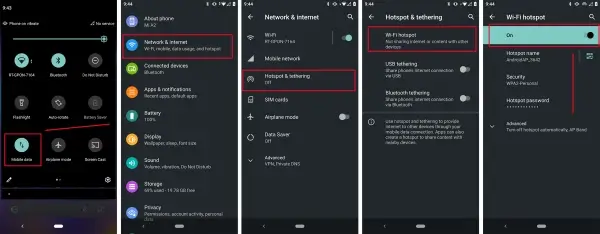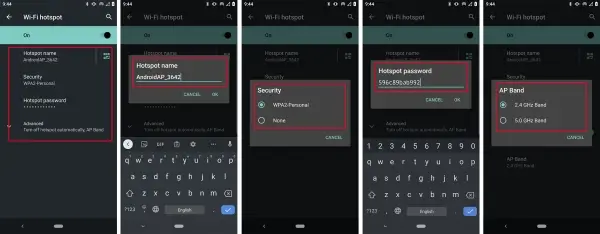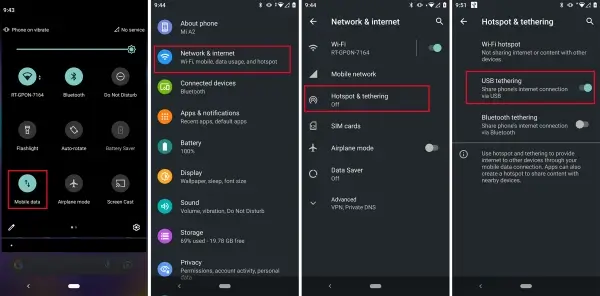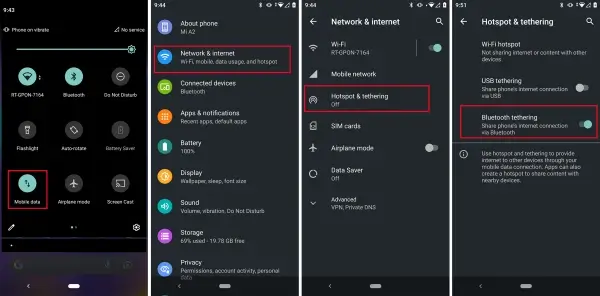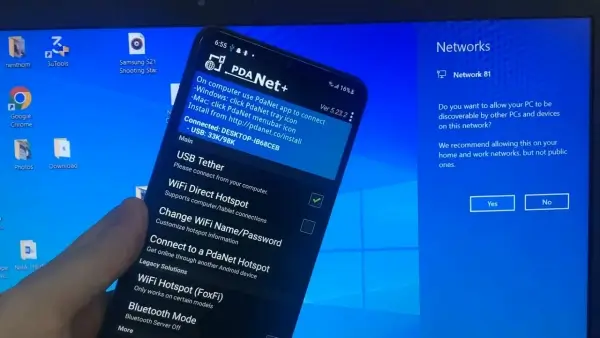How to share internet from a phone
A modern smartphone allows you to easily share the internet with various devices using several methods. This is especially relevant for people who frequently visit places where there is no possibility to connect to a public access point. Let's consider all possible ways to share the internet from a phone, which method is most relevant, and what is required for this.
Ways to share internet from your phone
Below you can familiarize yourself with a comparative table of all possible sharing methods. Additionally, we have introduced several criteria for comparing and evaluating each option.
| Sharing method | Wi-Fi | Bluetooth | USB cable |
| Setup | Very fast | 3-5 minutes | Fast |
| Connection speed | Medium-high | Low | High |
| Signal stability | Dependent on distance | Low | Stable |
How to share internet from a phone
The specific method of sharing internet depends on the device that will be using it. You can connect to a phone that shares internet in two ways - wirelessly and wired. Wireless methods include connections via Wi-Fi using the Wi-Fi Direct feature and via Bluetooth. Wired connection is done through a USB cable.
Wireless connection is possible for other smartphones and tablets, as well as laptops and computers equipped with a Wi-Fi module. If the computer does not have a built-in Wi-Fi module on the motherboard, the only possible way is to use a USB cable.
Below are detailed instructions for each type of connection, its setup on an Android smartphone, and a Windows-based computer.
Modem mode
This is the easiest way to share internet to other devices wirelessly. Almost every modern smartphone, starting from budget models, has a "Modem mode" function which allows you to use your mobile device as a router or access point for other devices to connect and use the internet.
To set up the access point and enable modem mode on Android, you need to:
- Swipe down the toolbar by dragging down from the top of the screen. Turn on the "Data transfer" function from the toolbar.
- Go to the "Settings" menu, "Network & internet" section.
- Depending on the Android skin, choose the "Mobile network" option, and make sure that the supported mobile internet SIM card is selected (only applicable to dual SIM devices).
- In the "Data transfer" section, go to "Access point and modem" or similar.
- Select "Mobile access point" or "Wi-Fi access point", and turn it on by toggling the switch to "On".
The network will start sharing based on the automatic settings. This is a universal instruction. The names of sections and items on your device may vary slightly, as many manufacturers use their own Android skins.
If needed, you can configure the access point in the same section where it was activated. The following options are available:
- Network name - the default name is displayed as "AndroidAP_..." or similar, which is visible to users of other devices. You can enter any custom name, such as the phone model, personal initials, or nickname.
- Security - the default setting is WPA2 PSK (Personal) with a certificate. It is not recommended to disable it, but the option is available.
- Password - the device automatically generates a password consisting of 12 alphanumeric characters, which needs to be shared with users planning to connect to the access point. You can change it to a shorter password of your choice.
- Automatically disable access point - this option is available in "vanilla" Android. It determines whether the access point will be automatically disabled if no other devices connect to it for a certain period of time.
- Wi-Fi frequency range - the default should be set to "2.4 GHz", which corresponds to Wi-Fi networks of the second generation. It is not recommended to change the frequency, as most smartphone models operate in this range. If the specific smartphones that will be connected support "5 GHz," then the range can be changed.
Via USB cable
Sharing internet from a phone via a USB cable is relevant for computers without a built-in Wi-Fi module. Usually, these are computers with a budget motherboard or older devices.
To make the computer detect the connection, you need to:
- Enable "Data transfer" from the toolbar on the phone.
- Connect the phone to the computer using a USB cable.
- Go to "Settings", "Network & internet", and then "Access point and modem".
- Enable "USB modem" by tapping on the corresponding line.
- On the computer, the drivers should automatically install. Then, open the "Network" section on the taskbar by clicking on the relevant icon.
- Select the available connection from the list and check if the connection is established. If not, manually connect and use the internet as intended.
Bluetooth connection
Sharing internet via Bluetooth is recommended only when the other methods are not suitable for some reason. Usually, this is the case when the computer does not have built-in Wi-Fi, but in these cases, there is usually no Bluetooth as well. Entry-level and mid-range motherboards have significant limitations in terms of functionality, especially for these types of interfaces. Bluetooth connectivity is available on almost every modern laptop.
So, to share internet via Bluetooth, you need to:
- Click on the "Start" button and go to "Settings/Control Panel". Then, go to the "Devices" or similar section on older versions of Windows.
- By default, the "Bluetooth and other devices" tab will be selected. The toggle switch near Bluetooth in the center of the window should be in the "On" position. Do not close the window and continue to the smartphone.
- On the phone, turn on "Data transfer" by swiping down the top of the screen to access the notification panel and tapping on the corresponding icon.
- After that, go to "Settings -> Network & internet -> Access point and modem" on the phone. Select "Bluetooth modem" by toggling the switch.
- Go back to the computer. In the "Bluetooth and other devices" window, the system will check for Bluetooth-compatible devices with an active connection and display the mobile device in the list.
- Select the phone from the list and click on the "Pair" button. A notification will appear on the phone, click on "Create pair". On the computer, confirm the connection.
After pairing the two devices, go to the "Taskbar" of the computer, right-click on the "Bluetooth" icon, and select "Connect to a personal area network (PAN)". A window will open, click on "Connect via" -> "Access point". The internet should be automatically established.
If this does not happen, select the "Connections" icon on the "Taskbar", right-click, and go to "Network & Internet Settings". The "Network status" window will open, in the "Advanced network settings" subsection, select "Adapter settings", the active Bluetooth connection, and click on "Properties".
Next, select "Internet Protocol Version 4 (TCP/IPv4)". The settings window will open, check the "Use the following DNS server addresses" option. In the "Preferred DNS server" field, enter "8.8.8.8", and in the "Alternate DNS server" field, enter "8.8.4.4". Enter each digit into the corresponding field, then confirm the data entry by clicking "OK".
How to share internet using special applications
In addition to the standard functions provided in the settings of modern smartphones, there are a number of applications that allow you to share internet, set connection speed limits, limit traffic, configure DNS, etc.
For most users, these applications are useless, but if your phone does not have the hotspot function, they can help you set it up. For example, apps like Osmino, FoxFi, or PDANet+ may be suitable for these tasks. Currently, they are not available on Google Play, but they can be downloaded from thematic forums.
Internet sharing apps on Google Play can be found by searching for "Wi-Fi tether". A whole list of utilities will be available to choose from, apply a filter for ratings above "4" and choose any app based on reviews. For example, Wi-Fi Connection Mobile Hotspot, Portable Wi-Fi Hotspot, Enable Tethering, etc.
Possible issues with sharing
Despite the simplicity of setting up internet sharing from a phone, some users may experience problems. We will try to answer the most common questions that we were able to find.
The laptop does not detect the internet-connected phone. On some laptop models, the control of wireless connections is managed by proprietary software, which can disable Wi-Fi or Bluetooth when there are no active processes. First, check if the "Bluetooth" and "Data transfer" functions are enabled on the phone. Then, check if the "Bluetooth" function is enabled on the laptop's taskbar. If the icon is not present, go to "Control Panel", then "Devices" and enable it.
The computer or laptop does not have internet access. There are no restrictions on sharing in the tariff plan. First, you need to uninstall and reinstall the Wi-Fi and Bluetooth drivers. The latest versions of the drivers can only be downloaded from the official website, taking into account the version of Windows. Secondly, recreate the connections. There may have been an error. If everything is done correctly, reinstalling the system may be necessary.
